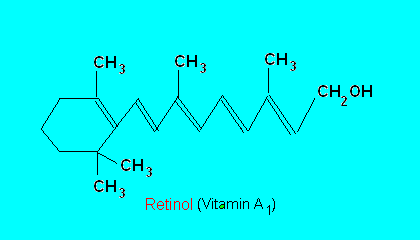
|
| Vitamin A |
|
Vitamin A is synthesized in the liver of vertebrates from b-carotene. Retinol derivatives, i.e. retinal (carbon 15 becomes an aldehyde group) and retinoic acid (carbon 15 becomes a carboxylic group) act as visual pigment and hormone, respectively. Retinoic acid binds to receptor proteins in the nucleus, which then interact with transcription factors thus modulating gene expression in the development of epithelial tissue, including skin (1). Most of the biological activity of vitamin A is carried out by the above derivatives although in many research articles mention is made of vitamin A when describing the action of this vitamin. |

|
1. Reichrath, J. et al. (2007) Horm.Metab.Res. 39(2) 71-84. Vitamins as hormones. 2. Ross, A.C. (2007) Vitam.Horm. 75, 197-222. Vitamin A supplementation and retinoic acid treatment in the regulation of antibody responses in vivo. 3. Cui, D., Moldoveanu, Z. and Stephensen, C.B. (2000) J.Nutr. 130, 1132-1139. High-level dietary vitamin A enhances T-helper type 2 cytokine production and secretory immunoglobulin A response to influenza A virus infection in BALB/c mice. 4. Semba, R.D. (1999) Proc.Nutr.Soc. 58(3) 719-727. Vitamin A and immunity to viral, bacterial and protozoan infections. 5. Guo, J. et al. (2006) J.Gastroenterol.Hepatol. 21(2) 443-448. Antitumor effects of all-trans-retinoic acid on cultured human pancreatic cancer cells. 6. Um, S.J. et al. (2003) Int.J.Cancer 107(6) 1038-1046. Novel retinoic acid derivative ABPN has potent inhibitory activity on cell growth and apoptosis in cancer cells. 7. Peters, A.J. et al. (1986) J.Nutr. 116(9) 1765-1771. Zinc-vitamin A interaction in pregnant and fetal rats: supplemental vitamin A does not prevent zinc deficiency-induced teratogenesis. 8, Nutrient Interactions (Bodwell, C.E. and Erdman, W., eds) CRC Press, Boca Raton, Fl. pp. 171-174, 1988. |
